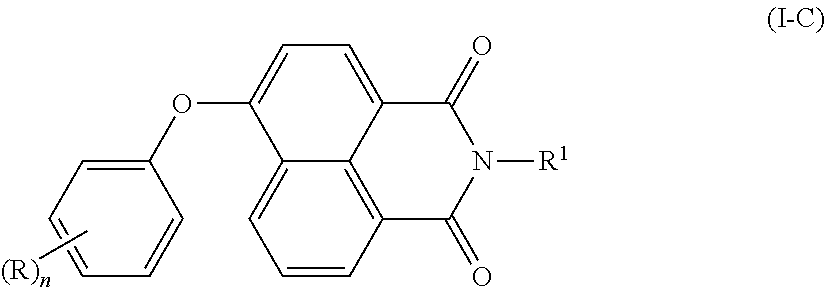Single- or multilayer, stabilized polyester film
a polyester film, single- or multi-layer technology, applied in the direction of stoppers, domestic articles, packaged goods, etc., can solve the problems of weak sharp decrease, and inability to achieve strong absorption of polyester film above 400 nm, etc., to achieve the effect of improving the binding into the polyester matrix
- Summary
- Abstract
- Description
- Claims
- Application Information
AI Technical Summary
Benefits of technology
Problems solved by technology
Method used
Image
Examples
example 1
[0103]An ABA film was produced as stated above with base-layer thickness 8.5 μm and outer layers A respectively of thickness 1.75 μm.
[0104]Outer layer A: 8% by weight of MB4 / 92% by weight of P1
[0105]Base layer B: 6% by weight of MB2 / 24% by weight of MB1 / 70% by weight of P1
example 2
[0106]An ABA film was produced as stated above with base-layer thickness 8.5 μm and outer layers A respectively of thickness 1.75 μm.
[0107]Outer layer A: 8% by weight of MB4 / 10% by weight of MB3 / 82% by weight of P1
[0108]Base layer B: 6% by weight of MB2 / 24% by weight of MB1 / 70% by weight of P1
[0109]Table 1 collates the properties of the films from the examples.
[0110]Whereas the films from Examples 1 and 2 have all of the properties demanded by the application, the film from Comparative Example 1, comprising no costabilizer, has certain shortcomings. Examples that may be mentioned of these shortcomings are the UV transparency in particular at relatively low wavelengths, and the relatively high level of fluorescence.
TABLE 1Properties of examplesMeasured Comparativevalueexample 1Example 1Example 2Thickness12 μm12 μm12 μmConcentration of I2% by wt.1.7% by wt.1.7% by wt.(CI)Standardized24% by wt.20.4% by wt.20.4% by wt.concentration of I·μm·μm·μm(CnI)Concentration of0% by wt.50% by wt.84...
PUM
| Property | Measurement | Unit |
|---|---|---|
| molar mass | aaaaa | aaaaa |
| transparency | aaaaa | aaaaa |
| wavelengths | aaaaa | aaaaa |
Abstract
Description
Claims
Application Information
 Login to View More
Login to View More - R&D
- Intellectual Property
- Life Sciences
- Materials
- Tech Scout
- Unparalleled Data Quality
- Higher Quality Content
- 60% Fewer Hallucinations
Browse by: Latest US Patents, China's latest patents, Technical Efficacy Thesaurus, Application Domain, Technology Topic, Popular Technical Reports.
© 2025 PatSnap. All rights reserved.Legal|Privacy policy|Modern Slavery Act Transparency Statement|Sitemap|About US| Contact US: help@patsnap.com



